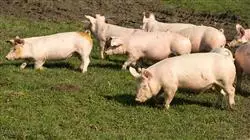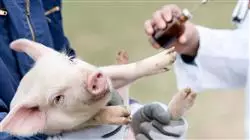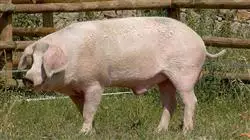University certificate
The world's largest faculty of veterinary medicine”
Description
We offer you the most comprehensive training in the market to bring Extensive Livestock Management to the same level as clinical and sanitary practice, offering your clients the highest quality in both services"

The Postgraduate diploma in Swine Economics and Genetic Resources in Extensive Farming Systems has a comprehensive program that covers the broadest spectrum of species and breeds used in Animal Production in Extensive Farming Systems. Not only is in-depth and specialized attention paid to the most common productions, but also to other much less common but highly relevant productions, which demand a greater degree of specialization from professionals in the area.
Likewise, the degree of knowledge and professional experience of the program's professors allows them to deal with very specific productions, where it is very difficult to access levels of specialization, except for the small number of people who have had the opportunity to develop their knowledge within the scope of this type of livestock farming.
This program is the most specialized since the development of each subject is structured according to the knowledge and experience of the teaching team, avoiding generalist voluntarism which, although it can provide acceptable global visions, lacks the capacity to study in depth each and every one of the subjects that need to be addressed with the highest quality.
The high levels of knowledge provided by the faculty in the areas of economics, genetics and animal breeding contribute decisively to consolidate and expand knowledge in two areas that are absolutely fundamental to achieve success in the management of extensive livestock production.
Immerse yourself in this high quality educational training, which will allow you to face the future challenges of Swine Economics and Genetic Resources in Extensive Farming Systems"
This Postgraduate diploma in Swine Economics and Genetic Resources in Extensive Farming Systems contains the most complete and up-to-date scientific program on the market. The most important features include:
- The development of case studies presented by experts in the management of veterinary centers
- The graphic, schematic, and practical contents with which they are created, provide scientific and practical information on the disciplines that are essential for professional practice
- News on Swine Economics and Genetic Resources in Extensive Farming Systems
- Practical exercises where self-assessment can be used to improve learning
- Special emphasis on innovative methodologies in Swine Economics and Genetic Resources in Extensive Farming Systems
- Theoretical lessons, questions to the expert, debate forums on controversial topics, and individual reflection assignments
- Content that is accessible from any fixed or portable device with an Internet connection
This Postgraduate diploma is the best investment you can make in selecting an up-to-date program to update your knowledge in Swine Economics and Genetic Resources in Extensive Farming Systems"
It includes, in its teaching staff, professionals belonging to the field of extensive livestock farming, who contribute to this training the experience of their work, in addition to recognized specialists from leading societies and prestigious universities.
The multimedia content, developed with the latest educational technology, will provide the professional with situated and contextual learning, i.e., a simulated environment that will provide immersive education programmed to learn in real situations.
This program is designed around Problem-Based Learning, whereby the professional must try to solve the different professional practice situations that arise throughout the program. To do so, the professional will be assisted by an innovative interactive video system created by recognized experts in Extensive Livestock Management.
This program comes with the best educational material, providing you with a contextual approach that will facilitate your learning"

A 100% online program will allow you to combine your studies with your professional work while increasing your knowledge in this field"
Syllabus
The structure of the contents has been designed by the best professionals in the Swine Economics and Genetic Resources in Extensive Farming Systems sector, with extensive experience and recognized prestige in the profession, endorsed by the volume of cases reviewed and studied, and with a broad command of new technologies.

We have the most complete and up-to-date educational program on the market. We strive for excellence and for you to achieve it too"
Module 1. Economic Aspects Related to Extensive Livestock Farming
1.1. Economics of Extensive Livestock Farming
1.1.1. The Production Factors; their Relationship and Importance; the SAFFE
1.1.1.1. Introduction
1.1.1.2. The Basis of SAFEE
1.1.1.3. SAFEE Objectives
1.1.1.4. Initial Conclusions
1.1.1.5. Second Conclusions
1.1.1.6. Third Conclusions
1.1.1.7. Fourth Conclusions
1.2. The Basis of Your Business Finances
1.2.1. Introduction
1.2.2. Accounting and its Types
1.2.3. Control and Development of Accounting Models
1.2.4. The Main Accounting Principles
1.2.5. Finance
1.2.6. Treasury
1.2.7. The Balance Sheet
1.3. Income Statement and Economic Flows
1.3.1. Introduction
1.3.2. Results Research
1.3.3. Economic and Financial Cash Flows
1.3.4. The Added Value
1.3.5. Initial Conclusions
1.4. Equity and Financial Analysis of Livestock Production
1.4.1. Introduction
1.4.2. Operation of the Financial Accounts
1.4.3. Equity Accounts
1.4.4. Difference Accounts
1.4.5. Profit and Loss Accounts
1.4.6. Checks
1.4.7. Arrangement of the Balance Sheet
1.4.8. Analysis of the Development of the Balance Sheet
1.4.9. Initial Conclusions
1.5. The Main Ratios to be Considered in Extensive Livestock Farming I
1.5.1. Introduction
1.5.2. The Relative Value of Ratios
1.5.3. Types of Ratios
1.5.4. Ratios to Evaluate Profitability
1.5.5. Ratios to Evaluate Liquidity
1.5.6. Debt Diagnosis Ratios
1.6. The Main Ratios to be Considered in Extensive Livestock Farming II
1.6.1. Introduction
1.6.2. Ratios for Diagnosing Asset Turnover
1.6.3. Collection Management Ratios
1.6.4. Payment Management Ratios
1.6.5. Other Ratios of Interest
1.6.6. Initial Conclusions
1.7. Bases of Livestock Economic Analysis
1.7.1. Introduction
1.7.2. Percentage Valuation
1.7.3. Analysis of Commercial Actions
1.7.4. Analysis of Expenses
1.7.5. Productivity Analysis
1.7.6. Analysis of Efficacy
1.7.7. Initial Conclusions
1.8. The Problem of Financing Extensive Livestock Farming
1.8.1. Introduction
1.8.2. Interest from Financing Sources
1.8.3. The Debt Policy and its Costs
1.8.4. The Structure of Indebtedness
1.8.5. Sources of Indebtedness
1.8.6. Self-financing
1.8.7. Initial Conclusions
1.9. Economic Planning in Extensive Livestock Farming I
1.9.1. The Budget
1.9.2. The Cash Budget
1.9.3. Budget Execution
1.9.4. The Flexible Budget
1.10. Economic Planning in Extensive Livestock Farming II
1.10.1. Analysis of Budget Deviations
1.10.2. The Interim Income Statement
1.10.3. Provisional Balance Sheet
1.10.4. Conclusions
Module 2. Genetic Resources of Extensive Populations and Programs for Improvement and Promotion of the Different Breeds
2.1. Relevance of Biodiversity in the Sustainable Development of the Planet
2.1.1. Biodiversity Concept
2.1.2. Importance of Biodiversity Conservation
2.1.3. Threats to the Maintenance of Biodiversity
2.2. Measurement of Genetic Diversity
2.2.1. Genetic Diversity
2.2.2. Consequences of the Loss of Genetic Diversity: Inbreeding
2.2.3. Molecular Tools for Measuring Diversity
2.2.4. Measures of Genetic Diversity
2.2.5. Genetics and Extinction
2.3. Animal Genetic Resources: Current Situation
2.3.1. Concept of Animal Genetic Resources
2.3.2. Distribution of Animal Genetic Resources at the Global Level
2.3.3. Distribution of Animal Genetic Resources by Domestic Species
2.3.4. Current Trends in Gene Flows
2.4. Methods of Conservation of Animal Genetic Resources
2.4.1. Inventory of Animal Genetic Resources
2.4.2. Conservation in situ
2.4.3. Conservation ex situ
2.5. Contribution of Native Breeds and the Extensive Farming System to the Maintenance of Biodiversity
2.5.1. Livestock and Landscape
2.5.2. Adaptation of Populations to the Environment
2.5.3. Conservation of Extensive Ecosystems
2.5.4. Livestock Utilization and Fire Prevention
2.6. Population Conservation Programs: Endangered Breeds
2.6.1. Justification for the Existence of Stock Conservation Programs. Socioeconomic Implications. Sustainable Development
2.6.2. Population Conservation Objectives
2.6.3. Stock Conservation Criteria
2.6.4. Methodology Used in the Conservation of Stocks
2.6.5. Forecast of Genetic Resources to be Utilized and Future Population Trends
2.7. Stock Enhancement Programs: Beef Cattle
2.7.1. Selection Objectives
2.7.2. Selection Criteria
2.7.3. Individual Identification and Parentage Control
2.7.4. Yield Control
2.7.5. Genetic Evaluations
2.7.6. Testing of Player Candidates
2.7.7. Dissemination of the Improvement
2.8. Population Improvement Programs: Small Ruminants
2.8.1. Selection Objectives
2.8.2. Selection Criteria
2.8.3. Individual Identification and Parentage Control
2.8.4. Yield Control
2.8.5. Genetic Evaluations
2.8.6. Testing of Player Candidates
2.8.7. Dissemination of the Improvement
2.9. Stock Improvement Programs: Extensive Pig Farming
2.9.1. Selection Objectives
2.9.2. Selection Criteria
2.9.3. Individual Identification and Parentage Control
2.9.4. Yield Control
2.9.5. Genetic Evaluations
2.9.6. Testing of Player Candidates
2.9.7. Dissemination of the Improvement
2.10. Population Conservation Programs: Other Species
2.10.1. Conservation Programs for Game Species
2.10.2. Conservation Programs for Other Species of Ecological Interest
Module 3. Iberian Swine and Other Extensive Swine Production
3.1. Introduction and Situation of the Sector
3.1.1. Global Situation
3.1.2. Situation Europe
3.1.3. Situation in Spain BORRAR
3.2. Racial Basis
3.2.1. Pure Breeds
3.2.2. Commercial Hybrids
3.3. Extensive Swine Production System
3.3.1. Spain BORRAR
3.3.2. Other Countries
3.4. Type of Farms
3.4.1. Iberian Pork
3.4.2. Non-Iberian Pork
3.5. Breeders and Breeding Techniques
3.5.1. Female Selection
3.5.2. Covering of Females
3.5.3. Gestation of Females
3.5.4. Childbirth
3.5.5. Selection and Final Destination of Males
3.6. Production Cycle
3.6.1. Nursing
3.6.2. Dairy
3.6.3. Bait
3.6.4. Finishing
3.7. Handling, Animal Welfare and Facilities
3.7.1. Extensive Swine Management
3.7.2. Animal Welfare in Extensive Swine Farms
3.7.3. Pig Management Facilities for Extensive Swine Production
3.8. Nutrition and Phased Program
3.8.1. General Aspects of Swine Nutrition
3.8.2. Feeding of Breeding Sows and Boars
3.8.3. Piglet Feeding
3.8.4. Feeding in the Fattening Phase
3.8.5. Feeding in the Finishing Phase
3.9. Health and Most Common Pathologies
3.9.1. Health in Extensive Swine Farms
3.9.2. Infectious Pathologies
3.9.3. Parasitic Pathologies
3.9.4. Nutrition-Related Pathologies
3.9.5. Pathologies Derived from Handling
3.9.6. Reproductive Pathologies
3.9.7. Other Pathologies
3.10. Legislation and Biosafety of Farms BORRAR
3.10.1. Legislation Regulating Pig Farms
3.10.2. Regulations Governing Products Derived from Iberian Pork
3.10.3. Regulations Governing Products Derived from Non-Iberian Pigs Farmed on an Extensive Regime
3.10.4. Biosafety in Extensive Swine Farms

This program will allow you to advance in your career comfortably"
Postgraduate Diploma in Swine Economics and Genetic Resources in Extensive Farming Systems
The extensive farming swine sector plays a fundamental role in the economy and in the preservation of the genetic resources related to this species. In this production system, pigs are raised in conditions that resemble their natural environment, which implies greater interaction with the environment and less dependence on external inputs. If you want to explore in depth the economic fundamentals and management practices related to raising swine in extensive farming systems, you've come to the right place. At TECH Global University you will find a complete Postgraduate Diploma that will help you achieve that purpose. The program has a 100% online mode of study and is composed of innovative teaching resources that will give a plus to your educational experience. The syllabus will allow you to explore aspects such as optimizing production, maximizing yields and minimizing costs, all while maintaining a sustainable and environmentally friendly approach.
Get your qualification with a Postgraduate Diploma in Swine Economics and Genetic Resources in Extensive Farming Systems
Why choose us? Because we not only have significant academic experience endorsed by major educational organizations and international media such as Forbes, but we offer a 100% online professionalization with infallible results. Our Postgraduate Diploma will provide you with a solid theoretical and practical education that will allow you to understand the key concepts of agricultural economics applied to swine in extensive systems. In addition, you will have access to up-to-date study materials and state-of-the-art technological tools, which will allow you to make the most of your learning experience. As you progress through the program, you will learn to analyze the economic factors that influence decision-making in swine husbandry, including feed costs, labor management, market prices and government regulations. Upon completion of the program, you will have the skills and knowledge necessary to develop professionally in the swine industry. You will be able to apply sound economic strategies and utilize genetic resources efficiently to maximize results in extensive swine farming systems.







